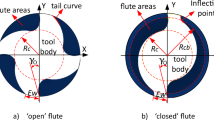Abstract
The flute plays an important role in the design process for tools. The complexity of the cutting edge is increasing continuously. Thus, it is difficult to grind flute precisely and efficiently. This paper presents a practical grinding method for the flute of tools. It solves the issue of how to grind the flute with the complex edge by standard wheels. It is summarized as follows: the curve of cutting edge and core are used as the designed parameters of the flute; we propose the fundamental conditions that the wheel does not interfere with designed parameters; we can find the posture and position of wheel in the curve frame easily, thus obtaining wheel trajectory. Finally, using a taper end mill as an example, the results show a good agreement between the CAM data and the model data. This proves the effectiveness of this method.








Similar content being viewed by others
Availability of data and materials
The datasets used or analyzed during the current study are available from the corresponding author on reasonable request.
Abbreviations
- \(O-XYZ\) :
-
Global coordinate system
- \({O}_{w}-{X}_{w}{Y}_{w}{Z}_{w}\) :
-
Coordinate system attached to wheel
- \({P}_{i}-{{\varvec{T}}}_{i}{{\varvec{B}}}_{i}{{\varvec{N}}}_{i}\) :
-
Moving frame attached to edge
- γ :
-
The rotation angle around T
- μ :
-
The angle between the normal vector of Gi and the axis of wheel
- \({R}_{\mathrm{t}}\) :
-
The radius of tool at Z = 0
- \({R}_{\mathrm{c}}\) :
-
The radius of core at Z = 0
- G :
-
The grinding point of wheel
- δ:
-
The rotation angle around N
References
Ehmann KF, Devries MF (1990) Grinding wheel profile definition for the manufacture of drill flutes. CIRP Ann Manuf Technol 39(1):153–156
Li GC (2017) A new algorithm to solve wheel profile for end mill groove machining. Int J Adv Manuf Technol 90(1–4):775–784
Li GC, Sun J, Li JF (2014) Process modeling of end mill groove machining based on Boolean method. Int J Adv Manuf Technol 75(5–8):959–966
Karpuschewski B, Jandecka K, Mourek D (2011) Automatic search for wheel position in flute grinding of cutting tools. CIRP Ann Manuf Technol 60(1):347–350
Zhang W, Wang XF, He F, Xiong DL (2006) A practical method of modelling and simulation for drill fluting. Int J Mach Tools Manuf 46(6):667–672
Nguyen VH, Ko SL (2013) Determination of workpiece profile and influence of singular point in helical grooving. CIRP Ann Manuf Technol 62(1):323–326
Li ZY, Zhang W, He Fengbao, Hu JZ (2014) Automatic search for grinding wheel position for twist drill CNC fluting. Journal of Dalian Polytechnic University 33:305–308
Ren L, Wang SL, Yi L, Yi LL, Sun SL (2016) An accurate method for five-axis flute grinding in cylindrical end-mills using standard 1V1/1A1 grinding wheels. Precis Eng 43:387–394
Habibi M, Chen ZC (2017) A generic and efficient approach to determining locations and orientations of complex standard and worn wheels for cutter flute grinding using characteristics of virtual grinding curves. J Manuf Sci Eng 139(4):041018
He YX (1999) Research on CNC grinding theory and programming technology for revolving cutting tools. Huazhong University of Science and Technology
Chen F, Bin H (2009) A novel CNC grinding method for the rake face of a taper ball-end mill with a CBN spherical grinding wheel. Int J Adv Manuf Technol 41(9–10):846
Funding
This research was funded by Projects of International Cooperation and Exchanges NSFC (51720105009).
Author information
Authors and Affiliations
Contributions
HW: methodology, conceptualization, validation, writing—original draft, term, data curation. XL: funding acquisition, writing—review and editing. CY: writing—review and editing. SW: writing—review and editing, data curation. GZ: writing—review and editing, data curation. KZ: writing—review and editing, data curation.
Corresponding author
Ethics declarations
Ethics approval
The content studied in this article belongs to the field of metal processing and does not involve humans and animals. This article strictly follows the accepted principles of ethical and professional conduct.
Consent to participate
The authors would like to opt in to In Review.
Consent for publication
The authors agree with the Copyright Transfer Statement.
Conflict of interest
The authors declare no competing interests.
Additional information
Publisher's note
Springer Nature remains neutral with regard to jurisdictional claims in published maps and institutional affiliations.
Rights and permissions
Springer Nature or its licensor (e.g. a society or other partner) holds exclusive rights to this article under a publishing agreement with the author(s) or other rightsholder(s); author self-archiving of the accepted manuscript version of this article is solely governed by the terms of such publishing agreement and applicable law.
About this article
Cite this article
Wang, H., Liu, X., Yue, C. et al. A novel grinding method for the flute with the complex edge by standard wheel. Int J Adv Manuf Technol 125, 577–586 (2023). https://doi.org/10.1007/s00170-022-10501-y
Received:
Accepted:
Published:
Issue Date:
DOI: https://doi.org/10.1007/s00170-022-10501-y




